Analysis of Child Labour in the UK: Causes, Effects, and Solutions
VerifiedAdded on 2023/06/18
|6
|1389
|178
Report
AI Summary
This report provides an overview of child labour in the UK, highlighting its socio-economic and cultural dimensions. It discusses how poverty, lack of education, and cultural beliefs contribute to the problem. The report explores arguments for and against child labour, emphasizing the importance of protecting children from economic exploitation and ensuring their right to education. It also suggests a multidisciplinary approach to tackle child labour, including addressing poverty, promoting education, and creating safe working environments where children's development is not compromised. The report concludes by advocating for equal educational opportunities and promoting awareness campaigns to foster a better understanding of child labour issues, with the aim of promoting children's welfare within the UK.
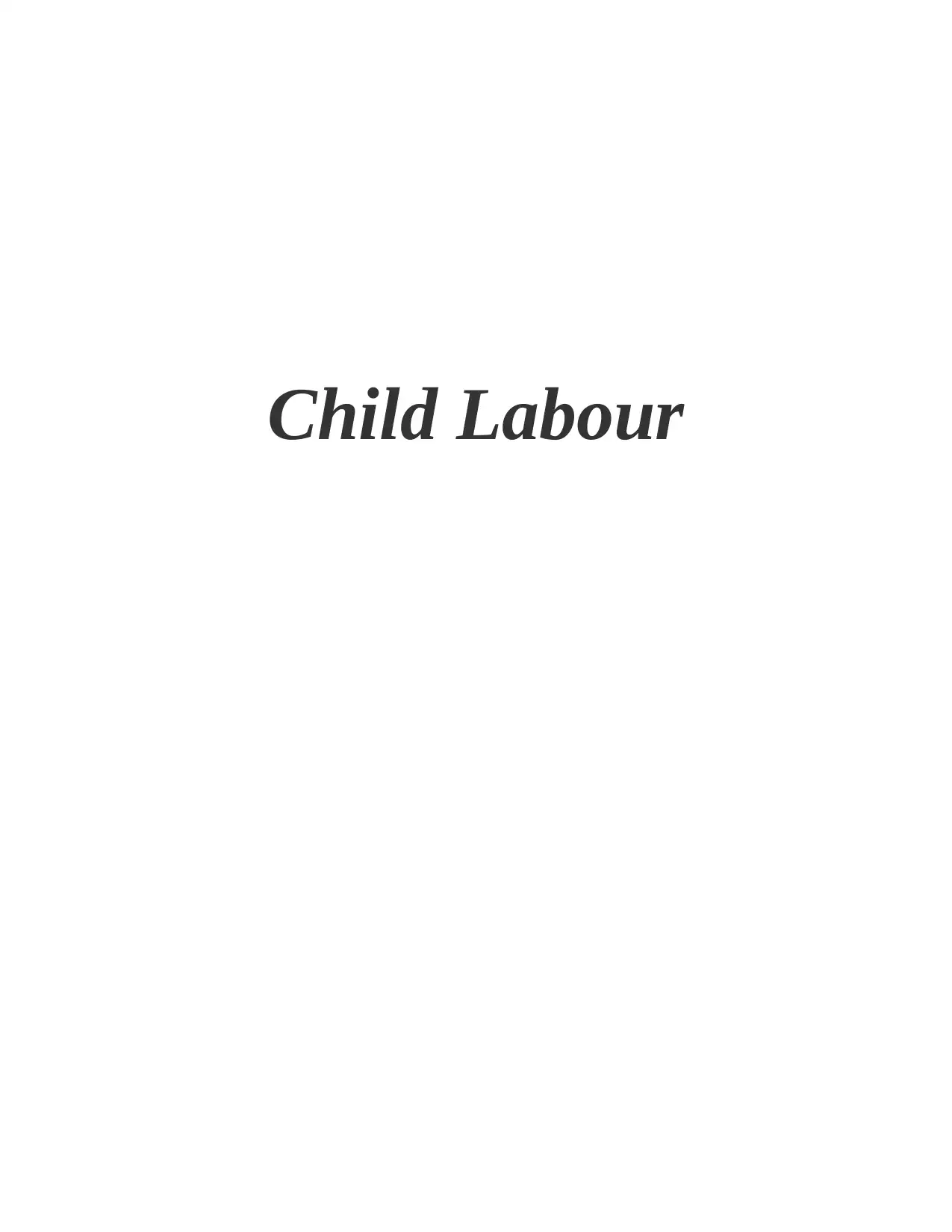
Child Labour
Paraphrase This Document
Need a fresh take? Get an instant paraphrase of this document with our AI Paraphraser

Table of Contents
INTRODUCTION...........................................................................................................................3
MAIN BODY...................................................................................................................................3
CONCLUSION................................................................................................................................3
REFERENCES................................................................................................................................4
INTRODUCTION...........................................................................................................................3
MAIN BODY...................................................................................................................................3
CONCLUSION................................................................................................................................3
REFERENCES................................................................................................................................4
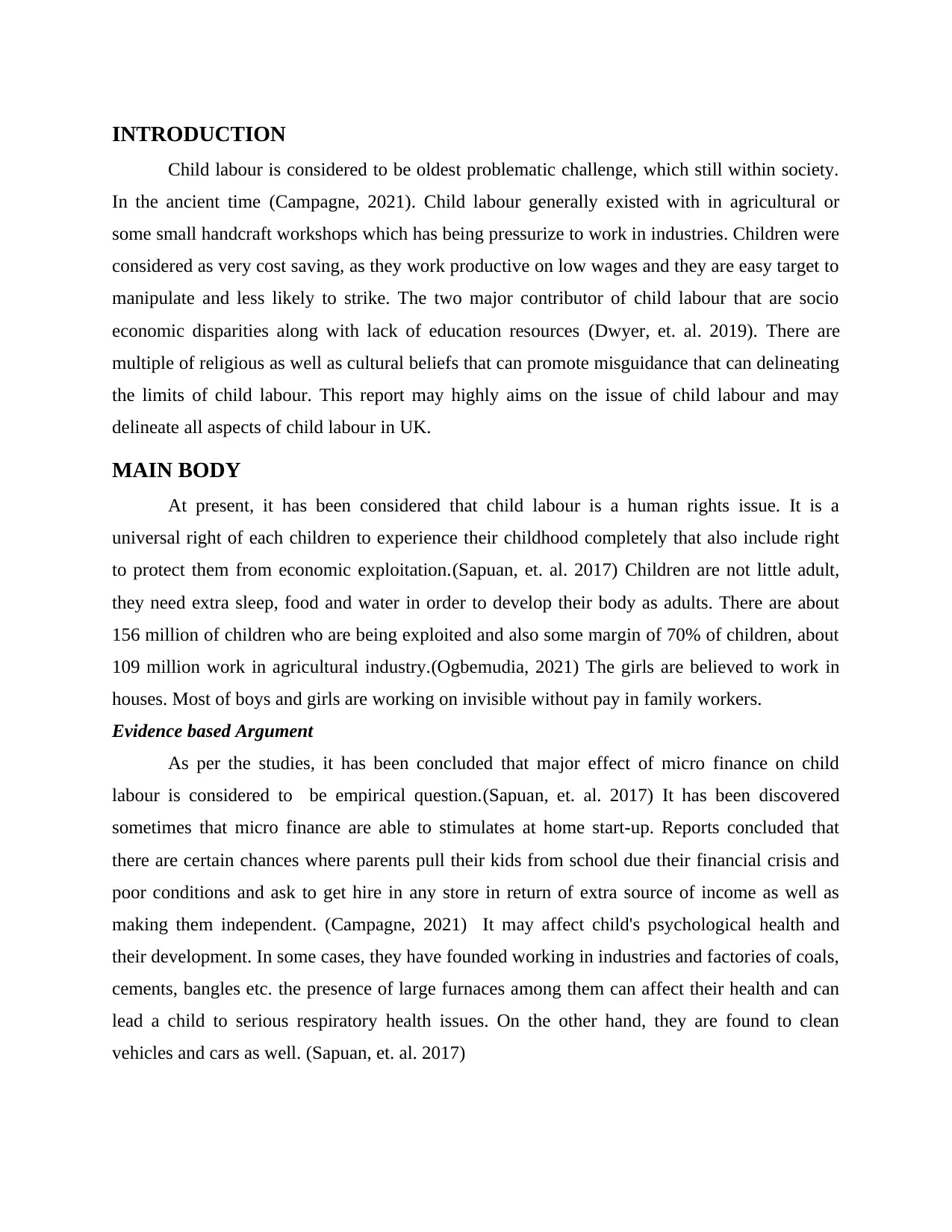
INTRODUCTION
Child labour is considered to be oldest problematic challenge, which still within society.
In the ancient time (Campagne, 2021). Child labour generally existed with in agricultural or
some small handcraft workshops which has being pressurize to work in industries. Children were
considered as very cost saving, as they work productive on low wages and they are easy target to
manipulate and less likely to strike. The two major contributor of child labour that are socio
economic disparities along with lack of education resources (Dwyer, et. al. 2019). There are
multiple of religious as well as cultural beliefs that can promote misguidance that can delineating
the limits of child labour. This report may highly aims on the issue of child labour and may
delineate all aspects of child labour in UK.
MAIN BODY
At present, it has been considered that child labour is a human rights issue. It is a
universal right of each children to experience their childhood completely that also include right
to protect them from economic exploitation.(Sapuan, et. al. 2017) Children are not little adult,
they need extra sleep, food and water in order to develop their body as adults. There are about
156 million of children who are being exploited and also some margin of 70% of children, about
109 million work in agricultural industry.(Ogbemudia, 2021) The girls are believed to work in
houses. Most of boys and girls are working on invisible without pay in family workers.
Evidence based Argument
As per the studies, it has been concluded that major effect of micro finance on child
labour is considered to be empirical question.(Sapuan, et. al. 2017) It has been discovered
sometimes that micro finance are able to stimulates at home start-up. Reports concluded that
there are certain chances where parents pull their kids from school due their financial crisis and
poor conditions and ask to get hire in any store in return of extra source of income as well as
making them independent. (Campagne, 2021) It may affect child's psychological health and
their development. In some cases, they have founded working in industries and factories of coals,
cements, bangles etc. the presence of large furnaces among them can affect their health and can
lead a child to serious respiratory health issues. On the other hand, they are found to clean
vehicles and cars as well. (Sapuan, et. al. 2017)
Child labour is considered to be oldest problematic challenge, which still within society.
In the ancient time (Campagne, 2021). Child labour generally existed with in agricultural or
some small handcraft workshops which has being pressurize to work in industries. Children were
considered as very cost saving, as they work productive on low wages and they are easy target to
manipulate and less likely to strike. The two major contributor of child labour that are socio
economic disparities along with lack of education resources (Dwyer, et. al. 2019). There are
multiple of religious as well as cultural beliefs that can promote misguidance that can delineating
the limits of child labour. This report may highly aims on the issue of child labour and may
delineate all aspects of child labour in UK.
MAIN BODY
At present, it has been considered that child labour is a human rights issue. It is a
universal right of each children to experience their childhood completely that also include right
to protect them from economic exploitation.(Sapuan, et. al. 2017) Children are not little adult,
they need extra sleep, food and water in order to develop their body as adults. There are about
156 million of children who are being exploited and also some margin of 70% of children, about
109 million work in agricultural industry.(Ogbemudia, 2021) The girls are believed to work in
houses. Most of boys and girls are working on invisible without pay in family workers.
Evidence based Argument
As per the studies, it has been concluded that major effect of micro finance on child
labour is considered to be empirical question.(Sapuan, et. al. 2017) It has been discovered
sometimes that micro finance are able to stimulates at home start-up. Reports concluded that
there are certain chances where parents pull their kids from school due their financial crisis and
poor conditions and ask to get hire in any store in return of extra source of income as well as
making them independent. (Campagne, 2021) It may affect child's psychological health and
their development. In some cases, they have founded working in industries and factories of coals,
cements, bangles etc. the presence of large furnaces among them can affect their health and can
lead a child to serious respiratory health issues. On the other hand, they are found to clean
vehicles and cars as well. (Sapuan, et. al. 2017)
⊘ This is a preview!⊘
Do you want full access?
Subscribe today to unlock all pages.

Trusted by 1+ million students worldwide
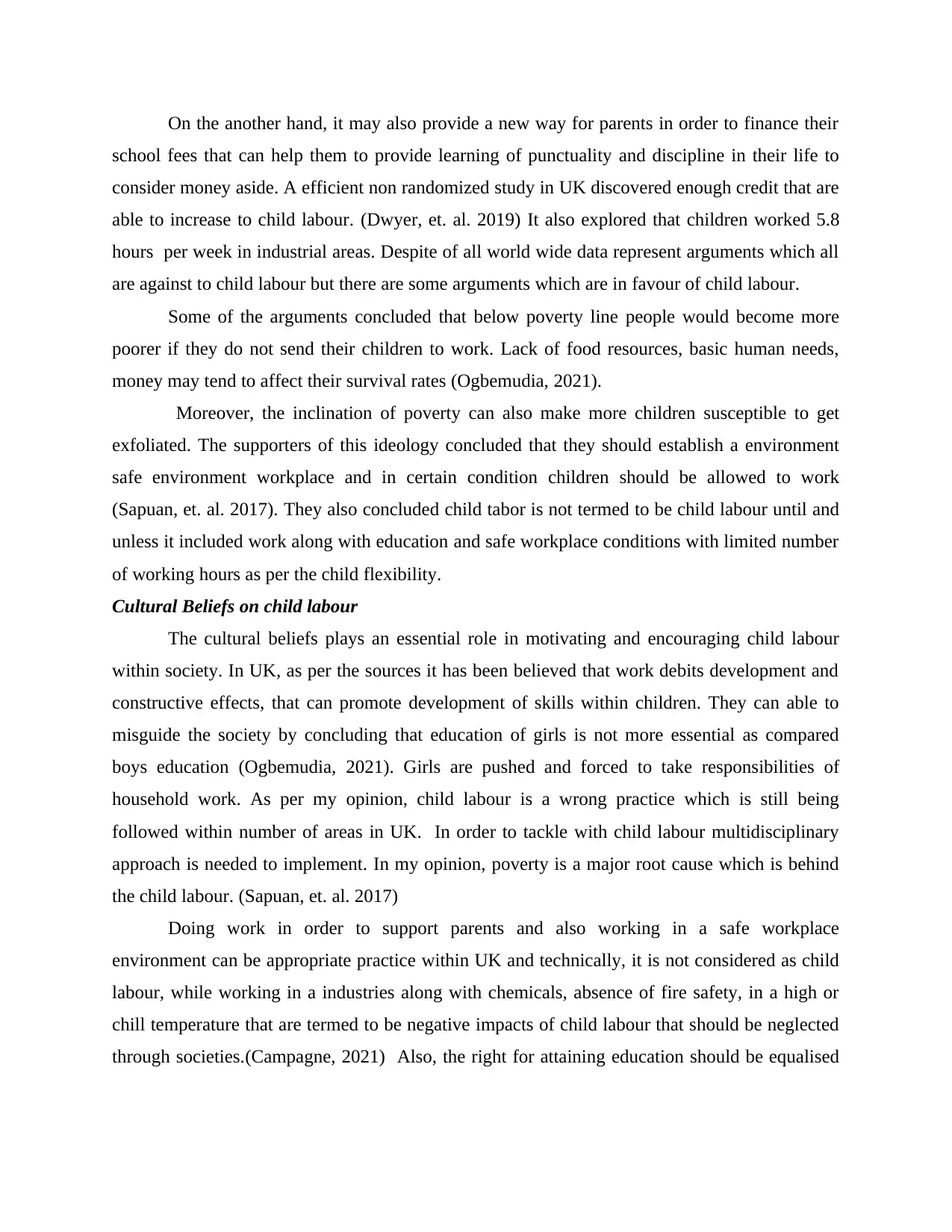
On the another hand, it may also provide a new way for parents in order to finance their
school fees that can help them to provide learning of punctuality and discipline in their life to
consider money aside. A efficient non randomized study in UK discovered enough credit that are
able to increase to child labour. (Dwyer, et. al. 2019) It also explored that children worked 5.8
hours per week in industrial areas. Despite of all world wide data represent arguments which all
are against to child labour but there are some arguments which are in favour of child labour.
Some of the arguments concluded that below poverty line people would become more
poorer if they do not send their children to work. Lack of food resources, basic human needs,
money may tend to affect their survival rates (Ogbemudia, 2021).
Moreover, the inclination of poverty can also make more children susceptible to get
exfoliated. The supporters of this ideology concluded that they should establish a environment
safe environment workplace and in certain condition children should be allowed to work
(Sapuan, et. al. 2017). They also concluded child tabor is not termed to be child labour until and
unless it included work along with education and safe workplace conditions with limited number
of working hours as per the child flexibility.
Cultural Beliefs on child labour
The cultural beliefs plays an essential role in motivating and encouraging child labour
within society. In UK, as per the sources it has been believed that work debits development and
constructive effects, that can promote development of skills within children. They can able to
misguide the society by concluding that education of girls is not more essential as compared
boys education (Ogbemudia, 2021). Girls are pushed and forced to take responsibilities of
household work. As per my opinion, child labour is a wrong practice which is still being
followed within number of areas in UK. In order to tackle with child labour multidisciplinary
approach is needed to implement. In my opinion, poverty is a major root cause which is behind
the child labour. (Sapuan, et. al. 2017)
Doing work in order to support parents and also working in a safe workplace
environment can be appropriate practice within UK and technically, it is not considered as child
labour, while working in a industries along with chemicals, absence of fire safety, in a high or
chill temperature that are termed to be negative impacts of child labour that should be neglected
through societies.(Campagne, 2021) Also, the right for attaining education should be equalised
school fees that can help them to provide learning of punctuality and discipline in their life to
consider money aside. A efficient non randomized study in UK discovered enough credit that are
able to increase to child labour. (Dwyer, et. al. 2019) It also explored that children worked 5.8
hours per week in industrial areas. Despite of all world wide data represent arguments which all
are against to child labour but there are some arguments which are in favour of child labour.
Some of the arguments concluded that below poverty line people would become more
poorer if they do not send their children to work. Lack of food resources, basic human needs,
money may tend to affect their survival rates (Ogbemudia, 2021).
Moreover, the inclination of poverty can also make more children susceptible to get
exfoliated. The supporters of this ideology concluded that they should establish a environment
safe environment workplace and in certain condition children should be allowed to work
(Sapuan, et. al. 2017). They also concluded child tabor is not termed to be child labour until and
unless it included work along with education and safe workplace conditions with limited number
of working hours as per the child flexibility.
Cultural Beliefs on child labour
The cultural beliefs plays an essential role in motivating and encouraging child labour
within society. In UK, as per the sources it has been believed that work debits development and
constructive effects, that can promote development of skills within children. They can able to
misguide the society by concluding that education of girls is not more essential as compared
boys education (Ogbemudia, 2021). Girls are pushed and forced to take responsibilities of
household work. As per my opinion, child labour is a wrong practice which is still being
followed within number of areas in UK. In order to tackle with child labour multidisciplinary
approach is needed to implement. In my opinion, poverty is a major root cause which is behind
the child labour. (Sapuan, et. al. 2017)
Doing work in order to support parents and also working in a safe workplace
environment can be appropriate practice within UK and technically, it is not considered as child
labour, while working in a industries along with chemicals, absence of fire safety, in a high or
chill temperature that are termed to be negative impacts of child labour that should be neglected
through societies.(Campagne, 2021) Also, the right for attaining education should be equalised
Paraphrase This Document
Need a fresh take? Get an instant paraphrase of this document with our AI Paraphraser
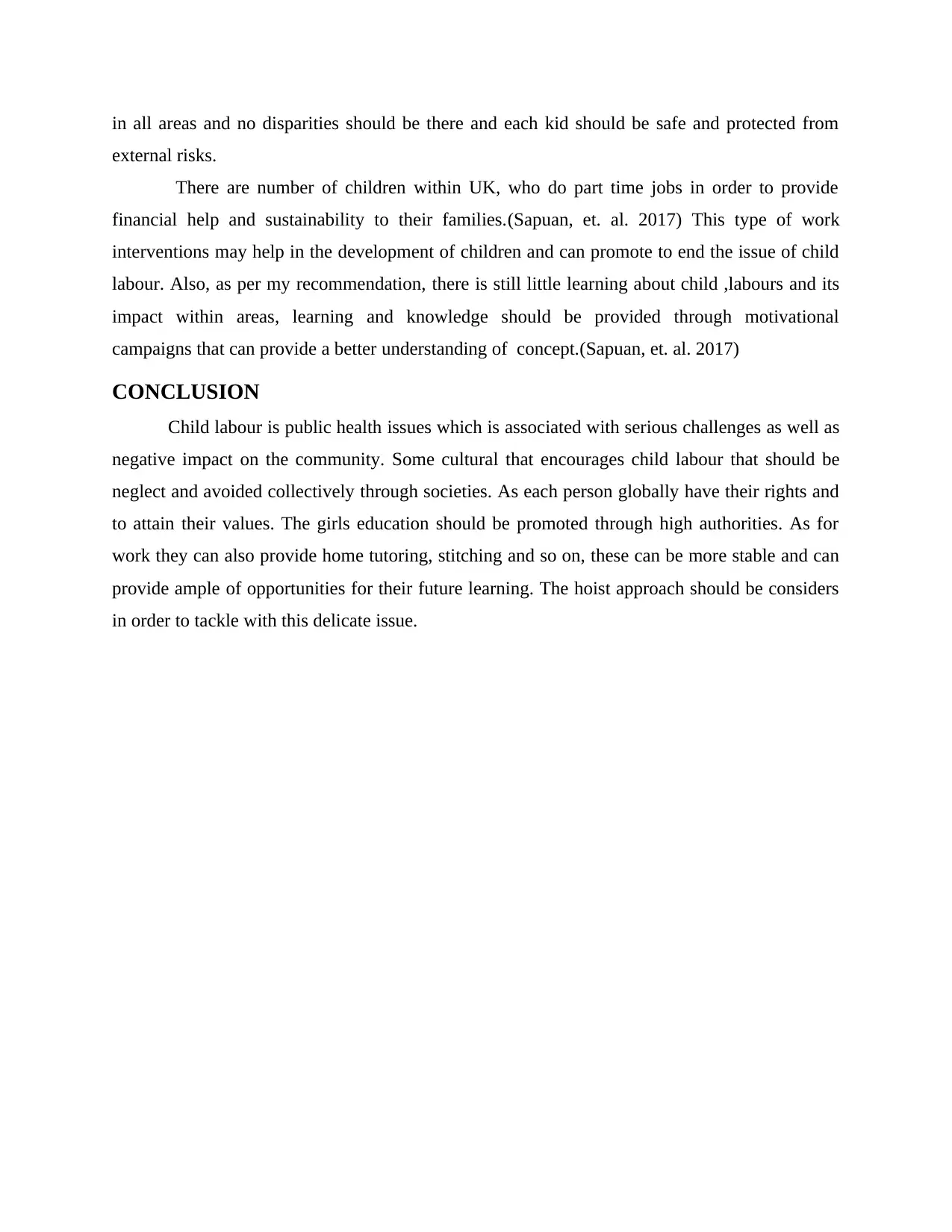
in all areas and no disparities should be there and each kid should be safe and protected from
external risks.
There are number of children within UK, who do part time jobs in order to provide
financial help and sustainability to their families.(Sapuan, et. al. 2017) This type of work
interventions may help in the development of children and can promote to end the issue of child
labour. Also, as per my recommendation, there is still little learning about child ,labours and its
impact within areas, learning and knowledge should be provided through motivational
campaigns that can provide a better understanding of concept.(Sapuan, et. al. 2017)
CONCLUSION
Child labour is public health issues which is associated with serious challenges as well as
negative impact on the community. Some cultural that encourages child labour that should be
neglect and avoided collectively through societies. As each person globally have their rights and
to attain their values. The girls education should be promoted through high authorities. As for
work they can also provide home tutoring, stitching and so on, these can be more stable and can
provide ample of opportunities for their future learning. The hoist approach should be considers
in order to tackle with this delicate issue.
external risks.
There are number of children within UK, who do part time jobs in order to provide
financial help and sustainability to their families.(Sapuan, et. al. 2017) This type of work
interventions may help in the development of children and can promote to end the issue of child
labour. Also, as per my recommendation, there is still little learning about child ,labours and its
impact within areas, learning and knowledge should be provided through motivational
campaigns that can provide a better understanding of concept.(Sapuan, et. al. 2017)
CONCLUSION
Child labour is public health issues which is associated with serious challenges as well as
negative impact on the community. Some cultural that encourages child labour that should be
neglect and avoided collectively through societies. As each person globally have their rights and
to attain their values. The girls education should be promoted through high authorities. As for
work they can also provide home tutoring, stitching and so on, these can be more stable and can
provide ample of opportunities for their future learning. The hoist approach should be considers
in order to tackle with this delicate issue.
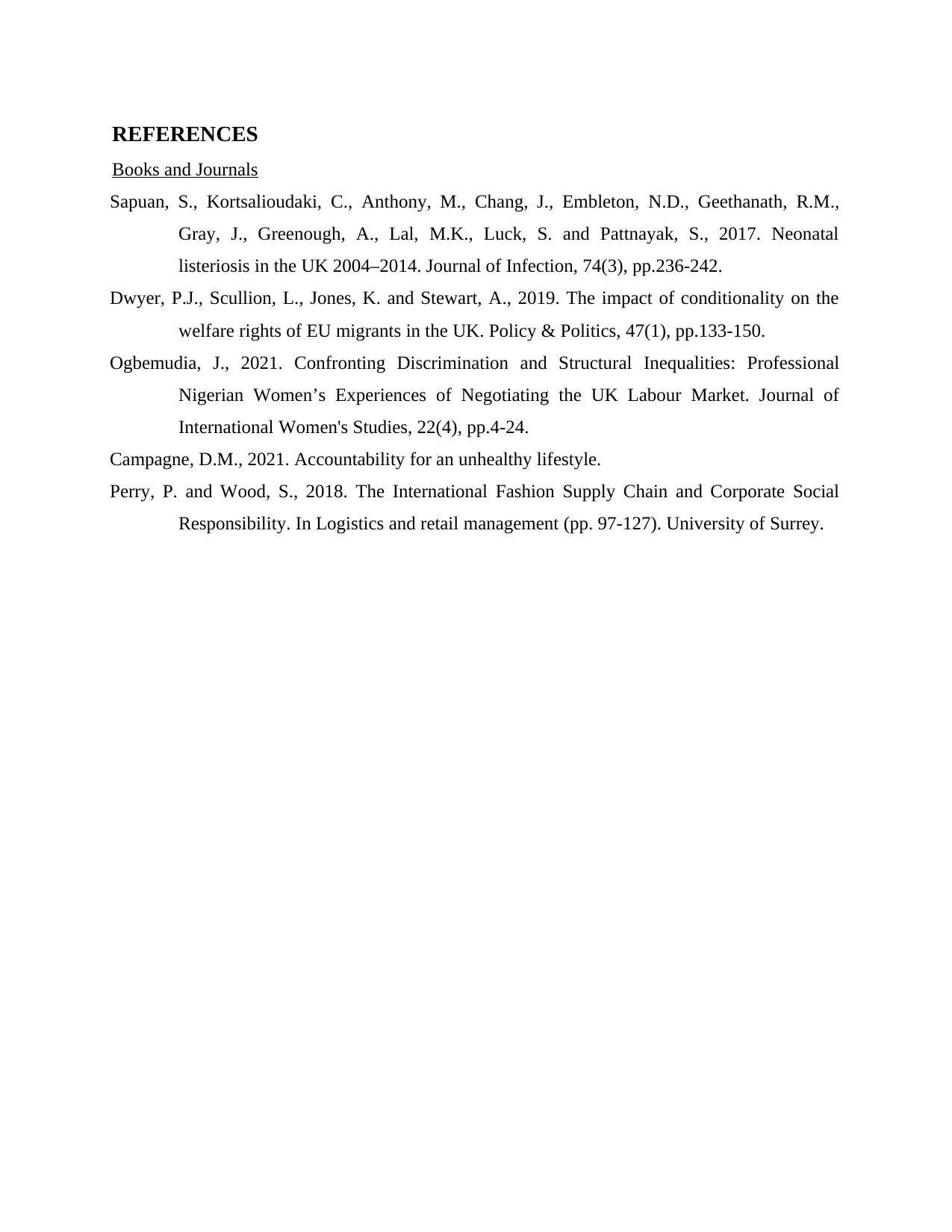
REFERENCES
Books and Journals
Sapuan, S., Kortsalioudaki, C., Anthony, M., Chang, J., Embleton, N.D., Geethanath, R.M.,
Gray, J., Greenough, A., Lal, M.K., Luck, S. and Pattnayak, S., 2017. Neonatal
listeriosis in the UK 2004–2014. Journal of Infection, 74(3), pp.236-242.
Dwyer, P.J., Scullion, L., Jones, K. and Stewart, A., 2019. The impact of conditionality on the
welfare rights of EU migrants in the UK. Policy & Politics, 47(1), pp.133-150.
Ogbemudia, J., 2021. Confronting Discrimination and Structural Inequalities: Professional
Nigerian Women’s Experiences of Negotiating the UK Labour Market. Journal of
International Women's Studies, 22(4), pp.4-24.
Campagne, D.M., 2021. Accountability for an unhealthy lifestyle.
Perry, P. and Wood, S., 2018. The International Fashion Supply Chain and Corporate Social
Responsibility. In Logistics and retail management (pp. 97-127). University of Surrey.
Books and Journals
Sapuan, S., Kortsalioudaki, C., Anthony, M., Chang, J., Embleton, N.D., Geethanath, R.M.,
Gray, J., Greenough, A., Lal, M.K., Luck, S. and Pattnayak, S., 2017. Neonatal
listeriosis in the UK 2004–2014. Journal of Infection, 74(3), pp.236-242.
Dwyer, P.J., Scullion, L., Jones, K. and Stewart, A., 2019. The impact of conditionality on the
welfare rights of EU migrants in the UK. Policy & Politics, 47(1), pp.133-150.
Ogbemudia, J., 2021. Confronting Discrimination and Structural Inequalities: Professional
Nigerian Women’s Experiences of Negotiating the UK Labour Market. Journal of
International Women's Studies, 22(4), pp.4-24.
Campagne, D.M., 2021. Accountability for an unhealthy lifestyle.
Perry, P. and Wood, S., 2018. The International Fashion Supply Chain and Corporate Social
Responsibility. In Logistics and retail management (pp. 97-127). University of Surrey.
⊘ This is a preview!⊘
Do you want full access?
Subscribe today to unlock all pages.

Trusted by 1+ million students worldwide
1 out of 6
Your All-in-One AI-Powered Toolkit for Academic Success.
+13062052269
info@desklib.com
Available 24*7 on WhatsApp / Email
![[object Object]](/_next/static/media/star-bottom.7253800d.svg)
Unlock your academic potential
Copyright © 2020–2025 A2Z Services. All Rights Reserved. Developed and managed by ZUCOL.


